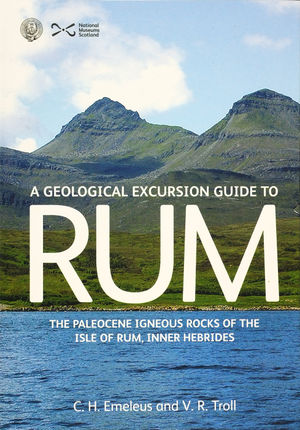Kinloch and surroundings, west of Kinloch, Rum - an excursion



Excursion XX from: Emeleus, C. H. and Troll, V. R. A geological excursion guide to Rum: the Paleocene igneous rocks of the Isle of Rum, Inner Hebrides. Edinburgh : Edinburgh Geological Society in association with NMS Enterprises Limited, 2008.
A. West of Kinloch
Take the Kilmory road west from Kinloch, along Kinloch Glen (See image). Sandstones belonging to the Scresort Sandstone Member of the Applecross Formation (TCAS) in the Torridon Group crop out in the adjacent Kinloch River and in roadside exposures. They have a general dip of 15–20º to the west-north-west. These sandstones occur on either side of the glen and cause the strong features on Mullach Mòr to the north (See image).
Locality 1.1 Kinloch Glen – sandstone intruded by dolerite plug and sheet [NM 3927 9987]
About 1 km from Kinloch a small dolerite plug and a south-dipping dolerite sheet are exposed in the roadside. Sandstone near the dolerite is somewhat bleached and has developed numerous irregular joints, both of which are features typically found near the numerous small doleritic and gabbroic intrusions in northern Rum.
Pass through the deer fence (close the gate) and continue along the track for 900 m, noting several north-trending dykes and exposures of dolerite (plugs).
Locality 1.2 Bridge over Allt Bealach Mhic Neill – peridotite plug in sandstone [NM 3803 9983]
At the bridge over the Allt Bealach Mhic Neill there are exposures of brown-weathering peridotite belonging to a plug more than 200 m wide.
Locality 1.3 Allt Bealach Mhic Neill – spectacular spherulithic structures in baked sandstone adjoining gabbro plug [NM 3803 9966]
Follow the path on the eastern (right-hand) side of the Allt Bealach Mhic Neill for about 250 m south, to the foot of a waterfall. The feldspathic sandstone (TCAS) in the stream bed has a spectacular spherulitic texture (Holness, 2002). The sandstone has been extensively recrystallised and partially melted by the gabbro plug seen in the left-hand stream bank. It contains quartz paramorphs after tridymite and relict quartz grains in a fine-grained felsic matrix. The alteration is considered to have occurred at a depth of about 700 m (Holness, 2002). Return to the bridge (Locality 1.2). On the north side of Kinloch Glen, the uniformly west-dipping sandstones on Mullach Mòr are seen to be interrupted by a wide cleft at [NG 379 005]. This is the site of a peridotite plug, with a small gabbro plug on its eastern margin. Turning towards the south and south-west, many slab-like outcrops are visible on the hillside. One large slab, about 300 m to the west-south-west of
the bridge, is formed by a gabbro plug [NM 379 997], but the majority are of sandstone that dips steeply (60º or more) to the north. They are part of a belt of steeply dipping strata that extends along the north side of the central complex, from A’Bhrìdeanach [NM 298 995] in western Rum to the hillsides south of Kinloch. The beds became tilted as doming developed over the central complex during the rise of felsic magmas in Stage 1. Return to Kinloch. (Total distance c. 2.5 km.)
| At all times follow: The Scottish Access Codeand Code of conduct for geological field work |